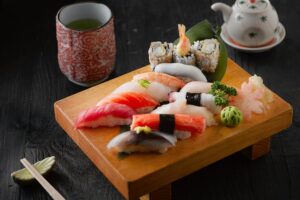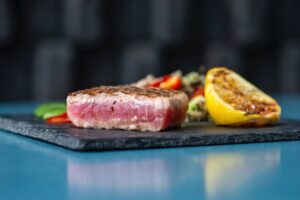Greetings, lovers of seafood! This in-depth analysis explores the world of seafood delights as we dissect the subtle differences between albacore and escolar.

Albacore, the adaptable “white tuna,” is a worthy contender in various recipes, while escolar, frequently referred to as the “butterfish,” adds its distinct flavors to the table.
Come along as we examine their unique qualities, uses in cooking, nutritional benefits, and crucial sustainability considerations.
Regardless of your level of experience cooking seafood, this guide aims to arm you with the knowledge you need to decide between albacore and escolar.
Escolar: The Butterfish
Escolar, also called the “butterfish,” has an elongated, sleek body that is darker on top and lighter on the belly. Its reputation as a delicacy is mainly due to its buttery texture and smooth skin.
Habitat and Geographic Distribution
Escolar thrives in deep oceanic environments and is primarily found in tropical and subtropical waters worldwide.
Escalon is frequently linked to areas like the Pacific and Indian Oceans due to its preference for warmer climates.
The Popularity of Culinary Uses in Restaurants
Escallions are in high demand in fusion and upscale cuisines because of their intense flavor and high oil content. Chefs value its adaptability and its distinctive flavor in everything from sushi to grilled dishes.
Potentially Harmful Effects and Disputes
Even though Escolar is praised for its flavor, there may be some health risks.
Because escolar contains a high wax ester content, some people may have digestive discomfort; this has led to advisories in some countries and culinary communities.
Albacore: The White Tuna
The sleek body and metallic blue-black upper side that gradually gives way to a silvery-white belly define albacore, also known as the “white tuna.”
Its elegant appearance is partly attributed to the length of its pectoral fins.
Patterns of Habitat and Migration
As a migratory species, albacore must travel great distances for favorable temperatures and food. It can be found in temperate and tropical waters but is most famous for its long migrations across the Atlantic and Pacific.
Applicability in Cooking and Adaptability
Albacore’s delicate and mild flavor makes it a versatile ingredient in many culinary traditions.
Albacore’s delicate flesh applies to various cooking techniques and appeals to multiple palates, whether served raw in sushi, grilled, or canned.
Health Benefits and Nutritional Profile
Albacore is highly valued because of its high protein content, omega-3 fatty acids, and essential nutrients.
Because of its nutritional profile, which supports heart health, improves cognitive function, and offers a valuable source of lean protein, it is a nutrient-dense option for consumers concerned about their health.

Flavor and Texture Comparison
Taste Profile of Escolar
Escolar is renowned for its rich, buttery flavor, often likened to fatty tuna. The succulent taste is complemented by a hint of sweetness, making it a favorite among those seeking a luxurious seafood experience.
However, the high oil content can contribute to the lingering richness of the palate.
Texture and Mouthfeel of Escolar
The velvety texture of escolar is a critical element of its appeal. Its flesh is exceptionally smooth, with a delicate and almost creamy consistency.
This unique mouthfeel enhances the dining experience, especially when prepared using methods highlighting its luxurious texture.
Taste Profile of Albacore
In contrast, albacore presents a milder flavor profile, making it a versatile canvas for various culinary creations. Its taste is often described as clean, light, and slightly sweet.
This subtlety allows albacore to harmonize with myriad flavors, adapting well to traditional and innovative recipes.
Textural Qualities and Consistency of Albacore
Albacore’s texture is firm and meaty, with a flaky consistency that holds up well in cooking.
Whether seared, grilled, or used in sushi, albacore’s robust texture provides a satisfying bite that appeals to those who prefer a more substantial mouthfeel in their seafood dishes.
Nutritional Comparison
Comparative Evaluation of Nutritive Value
Educating dietary decisions requires knowledge of the nutritional makeup of albacore and escolar.
Albacore has a leaner protein profile, but escolar is known for having a higher oil content and a rich source of omega-3 fatty acids. We will look at how these variations affect each fish’s health advantages.
The Importance of Omega-3 Fatty Acids
The abundance of omega-3 fatty acids in escolar promotes brain function and cardiovascular health.
Customers should be advised, though, that some people may experience digestive issues due to its unique wax ester content. Albacore is a leaner option because it contains a lower fat content despite omega-3s.
Additional Crucial Elements
Essential nutrients, including protein, selenium, vitamins D and B12, and escolar, are all present in albacore and escolar.
Albacore’s nutritional profile fits with a leaner, protein-focused diet, while escolar’s higher fat content adds to its caloric density.
Culinary Uses and Preparation
Popular Cooking Methods for Escolar
Escolar is a favorite in many culinary applications because of its unique flavor and luscious texture.
Cooks frequently choose techniques that bring out its inherent richness, like grilling, searing, or serving it raw in sushi. Because of its high oil content, it must not be overdone to preserve the desired velvety texture.
Recipes for Escolar Dishes
- Escolar Tataki: Lightly sear escolar slices and serve them with a zesty ponzu sauce.
- Escolar Nigiri: Highlight its buttery texture by featuring it in nigiri sushi with a touch of wasabi.
Cooking Techniques for Albacore

The firm texture and mild flavor of albacore make it suitable for a wide range of cooking techniques. Albacore is a versatile fish that can be eaten raw or cooked, making it a mainstay in traditional and modern cuisines.
Recipe Suggestions for Albacore-Based Meals
- Grilled Albacore Steaks: Marinate albacore steaks in herbs and citrus before grilling for a simple and flavorful dish.
- Albacore Poke Bowl: Combine diced albacore with fresh vegetables, rice, and a savory sauce for a nutritious and vibrant meal.
Sustainability and Environmental Impact
Overview of the Sustainability Status of Escolar
Escolar’s sustainability is a concern due to its vulnerability to overfishing and potential bycatch issues.
Consumers need to be aware of the source of escolar and choose suppliers who adhere to sustainable fishing practices. Look for certifications from reputable organizations that promote responsible seafood sourcing.
Sustainable Fishing Practices for Albacore
With its wide distribution and migratory patterns, Albacore can be harvested sustainably with proper management.
Pole-and-line or troll fishing methods are considered more environmentally friendly, as they minimize bycatch and impact on marine ecosystems.
Certification programs like the Marine Stewardship Council (MSC) can guide consumers toward sustainably sourced albacore.
Environmental Concerns Related to the Harvesting of Both Species
Overfishing, habitat destruction, and bycatch are common challenges associated with commercial fishing.
Consumers play a crucial role in supporting sustainable practices by choosing seafood from well-managed fisheries and staying informed about the environmental impact of their choices.
Conclusion
Albacore and escolar provide different culinary experiences as we end our investigation into these two fish species. Albacore, or white tuna, is a delightful fish with a mild flavor and various uses.
Escolar, on the other hand, stands out for its buttery richness and velvety texture.
Understanding the subtle differences in flavor, texture, and nutritional value between albacore and escolar is essential when choosing between the two.
Examining how our seafood choices affect the environment is equally important.
Choosing responsibly sourced fish helps maintain our oceans’ health and guarantees that these delicious fish will be around for future generations.
As you embark on your culinary journey, remember the advice on spotting high-quality goods, paying attention to possible health risks, and prioritizing sustainability.
Whether you are a home cook trying out new ingredients or a seafood expert, may this guide help you make wise choices and enjoy everything that albacore and escolar offer.
